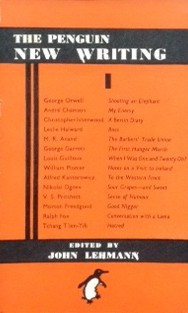Inspiring Older Readers
 posted on 07 Sep 2017
posted on 07 Sep 2017
Finding John Lehmann at the bottom of a box
Most compulsive book collectors (guilty!) know some of the legendary stories of unexpected or serendipitous finds – incredibly rare books picked up for a few pennies. Odd as it may seem to those who don’t understand this urge, for collectors (but probably not for dealers), these finds are not about monetary value but about being the owner of a special, rare book written by someone you’re interested in and whose books you want to read.
One such story tells of finding Edgar Allen Poe’s very first publication – a slim book of poetry published in paperback and where Poe’s name is replaced by the pseudonym ‘A Bostonian’ – at the bottom of a box of otherwise disposable pamphlets outside a book-cum-junk shop. The euphoria implicit in this find imprinted itself on my mind and I now simply have to root amongst the most unpromising piles of tat or be haunted by the possible loss of something great.
Truthfully I’ve never found anything as important and significant as the Poe first edition but I have turned up the occasional gem. I recently burrowed into a dauntingly huge pile of unpromising book boxes in a furniture clearance shop ( yes, there’s nowhere I won’t go if there’s a chance of a book rummage) I came up with John Lehmann’s The Penguin New Writing Number One. I was especially delighted because this modest paperback which was published in 1940 contains the first publication of George Orwell’s essay Shooting An Elephant and Orwell is a minor obsession of mine. This essay is one of the very first things of Orwell’s I ever read because it was included in an anthology I was set to read at secondary school as part of my O Level syllabus. So having this first publication positively lit-up my day. The book itself has a very modest monetary value – only a few pounds – but to me it’s just priceless.
The other spin-off from this find was that it sent me looking for some more information about John Lehmann who was the guiding spirit behind Penguin New Writing. It turns out that he has quite a colourful backstory. Born in 1907 he was a member of what was a substantial literary family that included the novelist Rosamond Lehmann. He was a key figure in the world of the literary Left in the 1930s and 40s and was close to Isherwood, Auden, the young Orwell and the influential British Communist Party member, Tom Winteringham – although there doesn’t seem to be any evidence that I can find that he was a CP member himself. He loathed his education at Eton and Oxford and considered it wasted time but he never quite fulfilled his aspirations to be a poet or creative artist in his own right. His future really lay in being a publisher and editor. He founded the hardback imprint New Writing in 1936 which was superseded by the paperback Penguin New Writing which lasted from 1940-1950. He had an on-off relationship with Virginia and Leonard Woolf and the Hogarth Press before he founded his own publishing house, John Lehmann Ltd, with his sister Rosamond. Although it was relatively short-lived -the publishing house closed in 1953 – it survived long enough to uncover the talents of Thom Gunn, Laurie Lee, Sartre and Stendhal in translation and the first two books of Elizabeth David.
He went on to found The London Magazine and from the mid-1960s onwards concentrated again on his own poetry. He died in 1987.
Lehmann’s active and pivotal role in 20th century literature is a story I knew nothing about prior to doing this modest bit of research but it has given my find at the bottom of a box yet another dimension. This little volume is now not only an emotional link with a great writer like Orwell but has become another small window on a history of literature that I hope will send me off onto other journeys.
Terry Potter
September 2017